Energy is used to make things move, light up, and heat up. It takes many forms, and it seems like we are always running out of it. But what exactly is energy? Does a gallon of gasoline have a lot of energy compared with a car battery or what can be obtained from a large solar cell or a windmill? This chapter will attempt to answer these questions, along with explaining how to calculate energy and power. When we put together these ideas of energy and power along with Newton’s laws and the equations of motion, we will have a very powerful set of tools for analyzing almost any type of mechanical motion (Figure 4.1).

FIGURE 4.1 Electrical power plant.
So, what exactly is energy?
Energy is defined by what it can do. We can use energy to perform work.
Energy: Energy is the capacity to do work.
Work: Work in physics is different from work in everyday life. The definition of work is
The work (W) done on an object equals product of the applied force (F) and the distance (d) the object moves through. cos (θ) is the angle between the applied force and the motion. The term F · cos (θ) can be thought of as the component of force in the direction of motion (Figure 4.2).

FIGURE 4.2 The work (W) done on an object equals product of the applied force (F) and the distance (d) the object moves through. cos (θ) is the angle between the applied force and the direction of travel.
Example 4.1
A car is pushed with 55 lb of force in the same direction in which the car moves (Figure 4.3). The car moves a distance of 6.0 ft. How much work is done?

FIGURE 4.3 How much work was done?
4.1 ENERGY/WORK UNITS
In the English system, work or energy is measured in foot pounds (ft lb). In the SI system, it is measured in newton meters (Nm) or joules (J).
English System | SI System | ||
|---|---|---|---|
Energy/work | ft lb | Nm or joules (J) | |
1 J = 1 Nm | |||
Conversions | |||
1 J = 0.74 ft·Ib | |||
Example 4.2
A cable is pulling a cart, making an angle of 45° with the direction of motion (Figure 4.4). The tension on the cable is 25 N and pulls the cart 3.0 m. What is the work done?

FIGURE 4.4 What is the work done?
In a system without any energy loss such as friction, the energy needed to perform some amount of work is equal to the work.
Energy = Work performed ← For a systemwithout any energy loss.
Example 4.3
How much energy is needed to perform 100 J of work? To perform 100 J of work, 100 J of energy is needed (assuming no energy is lost). Energy and work have the same units.
4.2 EFFICIENCY
Efficiency is a measure of how much energy is converted into some useful work. For a system that is not friction free, the efficiency will always be less than 100%.
Example 4.4
An automobile engine performs 9,500 J of work in order to move a car. The car consumes 47,500 J of energy by burning gasoline (Figure 4.5). What is the efficiency of this car?
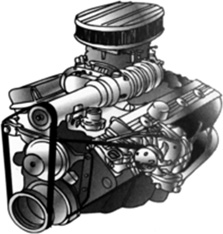
FIGURE 4.5 An automobile engine.
In a system with energy loss such as friction, the amount of work the system can perform is:
Example 4.5
A motor has 2,000 J of energy available to it, but it is only 80% efficient in converting this energy to work. How much work can it perform?
Energy can take two basic forms:
Potential energy is the energy stored in a system due to the arrangement of the position of its parts. A compressed spring, a weight raised to some height, and a battery with its charges separated all have potential energy (Figure 4.6). This energy is stored, waiting to be used. We will use the letter U to represent potential energy.

FIGURE 4.6 A weight raised to some height, a compressed spring, and a battery with its charges separated all have potential energies.
Kinetic energy means moving energy.
A hammer striking the head of a nail delivers its kinetic energy to the nail, forcing it into the wood some distance, performing some work. We will use the letter K to represent kinetic energy (Figure 4.7).

FIGURE 4.7 A hammer delivers its kinetic energy to a nail.
4.3 POTENTIAL ENERGY SOURCES
4.3.1 Gravitational
Energy can be stored by lifting something above the ground. This is gravitational potential energy. The energy can then be released, allowing it to fall back to the ground, turning this potential into kinetic energy (Figure 4.8).
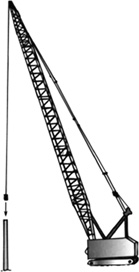
FIGURE 4.8 A pile driver. Potential energy is stored, then released, and turned into kinetic energy. The kinetic energy is delivered to the pile, performing some work.
Gravitational potential energy is given by the following formula.
Example 4.6
A water tower stores potential energy in the water by pumping it up into a tank, high above the ground. Suppose the tank is 10.0 m above the ground and contains 12,500 kg of water (Figure 4.9). What is the potential energy of this water?
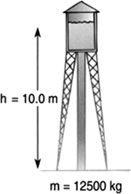
FIGURE 4.9 What is the potential energy of this water?
4.3.2 Springs
In order to compress or elongate a spring, work must be done on the spring. The energy used to perform this work is stored in the spring, waiting to be released (Figure 4.10).

FIGURE 4.10 A compressed or stretched spring stores potential energy.
4.3.3 Batteries
A battery is a source of potential energy. The amount of energy a battery can store is determined by how much charge it can store and its voltage (Figure 4.11).
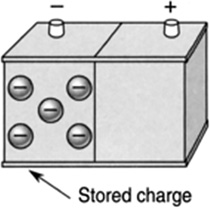
FIGURE 4.11 A battery separates charge to be used later to perform some useful work.
Example 4.7
Suppose an electric car is powered by a 12 V battery containing 4.1 MJ of energy. If it takes 150 lb or 668 N of force to move the car at a constant rate, how far can the car travel?
Assume an efficiency of 70%.
Since there is only 70% efficiency, the total energy available to do work is
This is only about 3 miles! Better increase the number of batteries!
4.3.4 Fuels
Fuels store chemical potential energy. A molecule of gasoline can be thought of as a bunch of atoms separated by compressed springs (Figure 4.12). The springs are the intermolecular forces between atoms. With the addition of heat, the springs will be released from compression, hurling the atoms outward. This is an explosion of the gas molecule that turns the chemical potential into kinetic energy. Listed below in Table 4.1 are the energies released when these fuels are burned.

FIGURE 4.12 Chemical potential energy is analogous to the energy stored in compressed springs.
TABLE 4.1
Energy Contained in Fuels

Actual values will vary slightly depending on geographical origin. Values do not include latent heat in any water vapor formed as a product of combustion.
Note: 1 MJ/kg = 1,000 kJ/kg = 1,000 J/g
Example 4.8
Calculate the gas mileage a car would get if the force needed to propel it along at some speed is 215 lb and the efficiency of the car is 20%.
The energy needed to travel 1 mile, or 5,280 ft, is:
The car will expend more energy than this because it is only 20% efficient.
The energy consumed in traveling 1 mile can be determined from:
Since the calculation was based on traveling 1 mile, the energy consumed per mile is:
Gasoline has an energy content of 9.7 × 107 ft lb/gal. The gas mileage is therefore:
Can you estimate the gas mileage of your car from a calculation like this?
4.4 KINETIC ENERGY
Kinetic energy means moving energy. If something moving strikes something stationary, it will deliver a force to it, causing it to move by imparting its energy to the stationary object. The formula for kinetic energy is:
Example 4.9
A rail gun consists of a U-shaped conductor with a sliding conducting rail lying across it. When a pulse of current is induced into the circuit, the rail will quickly move outward due to the magnetic fields generated in the loop (Figure 4.13).* Suppose a marble with a mass of 0.060 kg is placed on the rail and launched at a speed of 450 m/s. What is the kinetic energy of the marble?

FIGURE 4.13 A rail gun.
Example 4.10
How much work can be performed by an object that has 6,100 J of kinetic energy?
If there is a 100% efficient transfer of energy into work, then 6,100 J of energy can perform 6,100 J of work.
If the energy transfer into work is less than 100%, say 40%, the amount of work that can be done is:
Example 4.11
A batter hits a baseball with a mass of 2.1 kg, delivering 2,500 J of energy to it (Figure 4.14). At what speed is the ball traveling?

FIGURE 4.14 At what speed the ball is traveling?
4.5 WORK AND KINETIC ENERGY
To perform work on a mass means to apply a force on the mass and move it. This results in its velocity changing. A change in velocity means its kinetic energy has changed, which is described by the work-kinetic energy theorem:
ΔK = W
Change in Kinetic = Energy Work
Example 4.12
A mass of 2 kg at rest has a force of 3 N applied on it, moving it a distance of 4 m.
How much work was performed on the mass?
What is its change in kinetic energy?
What is its final velocity?
(a)
(b)
(c)
The mass started from rest so vi = 0.
Example 4.13
A hammer with 500 J of kinetic energy strikes a nail, driving it 0.01 m into a piece of wood (Figure 4.15). With what average force did the hammer strike the nail?

FIGURE 4.15 With what average force did the hammer strike the nail?
4.6 ENERGY CONSERVATION
The total energy of an isolated system is a constant. Energy is never created or destroyed; it just changes form. Even for a system that is less than 100% efficient, we can account for all of the energy used if we add up the work done, the energy wasted due to friction that went into heating up the system, any light or sound given off, or any other form the input energy may have turned into. Given this law, if something falls, losing some of its potential energy, the loss must be made up by gaining kinetic energy (neglecting air resistance).* Kinetic and potential energies are in balance. A pendulum illustrates this nicely (Figure 4.16).

FIGURE 4.16 Consider a pendulum. If the potential energy decreases, the kinetic energy increases.
The total energy of a system is made up of the sum of the kinetic and potential energies.
The conservation of energy says the total energy of an isolated system always stays the same; it is a constant. This is described mathematically by the following equation:
We can express the conservation of energy equation in another form:
Example 4.14
The water at the top of a waterfall has potential energy. If this water is allowed to fall back to the ground, its potential energy will be turned into kinetic energy (Figure 4.17). Suppose the potential energy of the water is 54,000 J at a height of 10.0 m. What is the kinetic energy of this water when it falls to the ground, and what is its velocity?
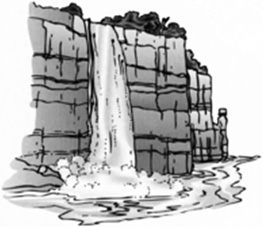
FIGURE 4.17 The potential energy stored is turned into kinetic energy when the water flows downward.
Using the conservation of energy:
The initial potential energy equals: Ui = 54,000 J.
All of this energy is turned into kinetic energy so:
From the problem, Ki = 0 and Uf = 0.
4.7 WORK AND POTENTIAL ENERGY
Recall that the work done on a mass is the force applied on the mass in the direction of the motion of the mass. A conservative force is a force where the work done on a particle does not depend on the path the mass is pushed or pulled through by the force. An example of a conservative force is gravity, or electric forces, or the force associated with a spring. In the case of gravity or a spring, the change in potential energy and the work done on a particle depends only on the initial and final positions of the system, and not on the path taken. Conservative forces therefore have associated with them a potential energy. Work done by a frictional force is an example of a non-conservative force, because the work depends on the path and not just the end points.
Putting together the conservation of energy, the work-kinetic energy theorem, and the idea of a conservative force:
Finally, we get:
Example 4.15
To illustrate ∆U = − WC calculate the work done and change in the potential energy of a mass of 2 kg lifted from ground level to 3 m above the ground.
Calculating the change in potential energy:
Calculating the work done:
Here we use a = –g because the force points in the opposite direction as the motion.
Comparing W and ∆U we see:
4.8 POWER
Power is the rate at which energy is used.
If a lot of energy is used quickly, then a lot of power is consumed.
Power is measured in watts, or horsepower.

Example 4.16
A light bulb consumes 100 J of energy every 2 s (Figure 4.18). How much power is being consumed?
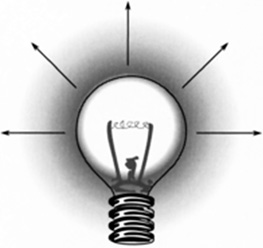
FIGURE 4.18 How much power is being consumed?
E = 100 J
T = 2 s
P = 50 W
Example 4.17
A crane lifts a crate with a force of 250 lb, 10 ft in the air in 5 s (Figure 4.19). How much work was done? How much energy was used and power consumed?

FIGURE 4.19 How much energy was used and power consumed?
Example 4.18
A lawn mower is rated at 3 hp (Figure 4.20). What is this power in watts?
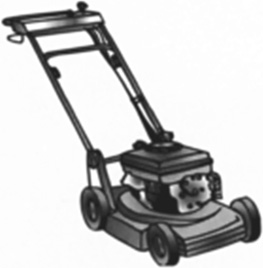
FIGURE 4.20 What is this power in watts?
4.9 KILOWATT-HOURS
The power meter in your house keeps track of how much energy you use (Figure 4.21). It does this by keeping track of how many kilowatts are used and the length of time those kilowatts are used for, remember (Energy = Power × Time). The meter reading is given in kilowatt-hours (kWh), because we pay for energy, not power.
Energy(kWh) = kilowatts × hours
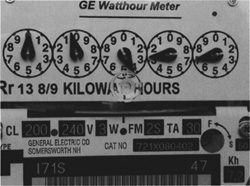
FIGURE 4.21 Electrical power meter.
Example 4.19
A hair dryer consumes 1.2 kW of power and is run for 0.1 h (Figure 4.22). What is the energy consumed?
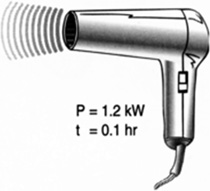
FIGURE 4.22 What is the energy consumed?
Example 4.20
The electrical power company charges you by the number of kilowatt-hours used. Suppose the power company charges 9 cents/kWh. How much does it cost you to leave a 100 W light on for 8 h? This problem is, effectively, a conversion from kilowatt-hours to cents.
4.10 POWER, FORCE, AND VELOCITY
Power, force, and velocity are related through the formula:
Example 4.21
A girl pedals her bike, pushing down on the pedals while generating 55 lb of force between the wheel and the road (Figure 4.23). She is traveling at 10 ft/s. How much power is the girl transmitting to the bike?

FIGURE 4.23 How much power the girl is transmitting to the bike?
Example 4.22
You are asked to design an elevator to transport 1,900 lb of freight at a constant speed using a 10 hp motor (Figure 4.24). How fast will the elevator car move?

FIGURE 4.24How fast will the elevator car move?
4.11 OTHER SOURCES OF ENERGY
Comparing Energy Sources: What is the difference between gas, coal, and nuclear power? The electrical energy generated from gas, coal, and nuclear fuel is not a direct conversion. The heat generated from these three fuel sources is used to boil water, to make steam. This steam is then directed at a turbine to turn an electrical generator (Figure 4.25).

FIGURE 4.25 Gas, coal, and nuclear power are all used to heat water to generate steam, to turn a turbine connected to an electrical generator. The only difference between them is the fuel used to heat the water.
4.11.1 Fuel Cells
Fuel cells function like a battery in that they derive their electrical energy from a chemical reaction (Figure 4.26). Unlike a battery, they never need to be recharged. They do require fuel, however, in the form of hydrogen and oxygen. A fuel cell consists of two electrodes contained in an electrolyte. Hydrogen flows over one electrode and oxygen flows over the other. A chemical reaction takes place at the electrodes, removing an electron from the hydrogen, attaching itself to one electrode (the cathode) and the positive proton to the other electrode (the anode). This buildup of opposite charges on two electrodes makes for a device that functions like a battery.

FIGURE 4.26 A fuel cell.
4.11.2 Wind
A windmill can take the kinetic energy of the wind and use it to pump water, mill corn, and generate electricity (Figure 4.27). How much energy does wind have? The energy contained in the wind depends on its velocity, density, and moisture content.
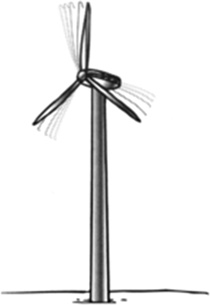
FIGURE 4.27 A windmill converts the wind’s kinetic energy into rotational energy to be used for some purpose, such as generating electricity or pumping water.
4.11.3 Hydroelectric Energy
Hydroelectric energy is the energy captured from falling water (Figure 4.28).
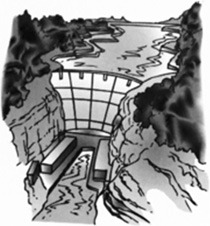
FIGURE 4.28 Hydroelectric power is power generated from falling water.
4.11.4 Solar Energy
Solar cells convert the energy contained in sunlight into electrical energy (Figure 4.29). On a sunny day, about 1,000 W/m2 of energy is contained in the sunlight that reaches earth. Currently, solar cells can at best convert about 20% of this energy into electricity. A solar cell is basically made of two materials called P and N materials. The P and N are placed next to one another, and this combination is called a PN junction. As light makes its way to the junction, it knocks free electrons on the P side, and they are transported to the N side because of the electric field present in every PN junction. A grid is placed over the solar cell to collect these electrons on the front, and a metal film on the back acts as the positive terminal. The cell now acts like a battery, deriving its energy from light instead of some chemical reaction (Figure 4.30). Currently, at about 12.2 cents/kWh, solar power is becoming comparable to electricity from the utility companies (about 12 cents/kWh).

FIGURE 4.29 A solar cell.
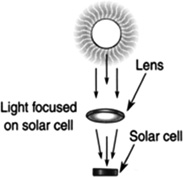
FIGURE 4.30 Lenses help collect more light to focus on the solar cell.
4.11.5 Lightning
A bolt of lightning contains millions of joules of energy (Figure 4.31). It would be great if we could capture and use it. Research is currently seeking ways to capture this energy. One of the biggest problems to overcome in this field is finding a way to collect the energy without destroying the equipment used to collect it!

FIGURE 4.31 A lightning bolt contains millions of joules of energy.
4.11.6 Fusion
Fusion Power, ITER: International Thermonuclear Experimental Reactor is the world’s largest nuclear fusion reactor located in southern France. It consists of a magnetic “bottle”, shaped like a doughnut surrounded by a magnetic field. This design is called a Tokomak, Figure 4.32. A gas of isotopes of hydrogen, tritium, and deuterium are contained in the Tokomak. The gas is heated to temperatures of 100,000,000°C by running a current through the gas. The magnetic field keeps the plasma away from the walls of the reactor to prevent it from melting. At such high temperatures, the tritium and deuterium are moving very quickly inside the vessel and they occasionally slam into one another with such force that they stick together forming a new atom, helium, Figure 4.33. Heat energy is given off in the process. This process is called fusion and is the source of the sun’s energy. The heat released in this process is used to boil water to create steam to power an electrical generator.
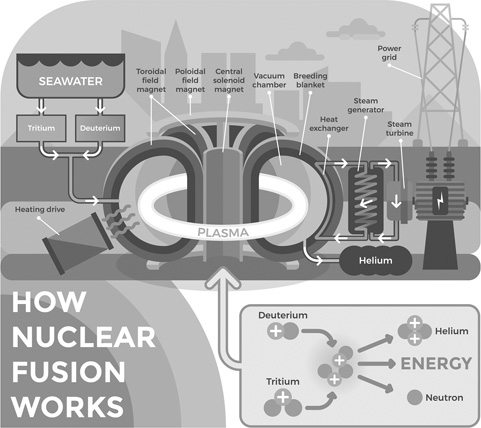
FIGURE 4.32 A Tokomak fusion reactor consists of a magnetic “bottle”, shaped like a doughnut surrounded by a magnetic field to contain the hot plasma undergoing fusion.

FIGURE 4.33 At high temperatures, the tritium and deuterium are moving very quickly inside the vessel and they occasionally slam into one another with such force that they stick together forming a new atom, helium. Heat energy is given off in the process.
4.12 CHAPTER SUMMARY
Symbols used in this chapter:
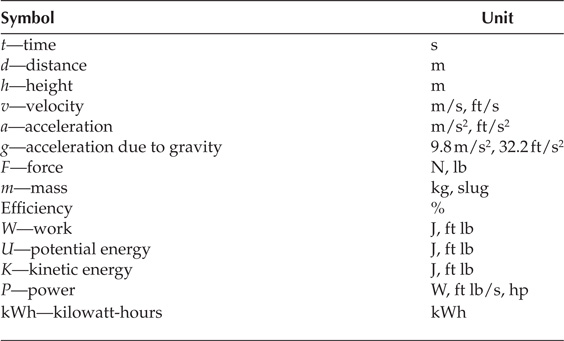
4.12.1 Conversions
1 J = 1 Nm
1 J = 0.74 ft lb
1 hp = 746 W
Energy is the capacity to do work.
Potential energy = mass (kg) × gravity (m/s2) × height (m)
Conservation of energy says: ΔE = ΔK + ΔU = 0
Power is the rate at which energy is used.
Power is measured in watts, or horsepower.
English and Metric units
Power: , hp, W
Power, force, and velocity are related through the formula:
PROBLEM SOLVING TIPS
∎ All problems dealing with electricity and energy should be solved using the MKS system of units.
∎ There are a lot of formulas in this chapter, so keep a formula sheet in front of you while solving the problems.
PROBLEMS
A computer’s CD drive pushes out a CD holder with 0.5 lb of force, through a distance of 0.4 ft and takes only 1 s to eject. How much work was done?
Convert 25 J into ft lb.
An elevator motor consumes 81,000 J of energy in lifting 3,500 N of weight at a constant velocity through a distance of 4 m. What is the efficiency of this motor?
How much energy is required to pick a 1 kg book off the ground and raise it to a height of 1.2 m?
A battery contains 500,000 J of energy and is connected to a 100 W light bulb. How long will the light remain lit?
A kick boxer delivers a punch to his opponent. Suppose his fist weighs 5 lb and is moving at 10 ft/s. What is the energy contained in his fist (remember to convert the weight to mass first)? If all this energy is delivered to his opponent, pushing his jaw back by 1 in., what is the average force contained in his punch (remember to convert inches to feet)?
You build an electric generator by connecting your 3.5 hp lawn mower engine to a car alternator. Assume the efficiency of this system is 40%. How many watts can you generate with this generator?
What is the minimum power required by a conveyer belt to lift a 150 kg package to a height of 2.0 m in 3.0 s?
In a hydroelectric power plant, suppose that water falls for a distance of 110 m before reaching the turbine/generator. What is the speed of the water when it reaches the turbine?
Suppose the water in problem 9 strikes the turbine with 1.2 × 106 N of force. What power is delivered to the turbine? Suppose the efficiency of this system is 21%. How many watts does the system put out?
How much work is done in pulling a wagon with a force of 15 lb for a distance of 10.0 ft when the handle makes an angle of 45 ° with the horizontal?
Use energy conservation to calculate how fast an apple will hit Isaac Newton’s head if he is sitting below the tree and the apple falls 5.0 ft onto his head.
What is the approximate amount of energy a bat must deliver to a baseball if it is to knock it out of the park for a distance of 450 ft?
An electric car is driven by a 65 hp electric motor that is 80% efficient. If it is traveling at 55 mile/h, for a distance of 56 miles, how much energy did the batteries consume?
A mass of 0.5 kg starting at rest then has 1,100 J of work performed on it. What is its final velocity?
A motor is used to lift an elevator upward with 5,000 N of force for a distance of 3 m. How much work was performed?
In the previous problem, if the motor consumes 20,000 J of energy, what is the efficiency of the system?
If a motor consumes 20,000 J of energy in 1.2 s, what is the power of the motor?
A “Killer Satellite” uses a rail gun to shoot another satellite. The gun delivers 6,100 J of energy to a projectile with a mass of 0.3 kg. What is the velocity of the projectile?
The rail gun in problem 19 delivers its energy to the projectile over a distance of 1.0 m. What force was applied on the projectile?
A 300 W TV set is left on for 8 h. How many kWh of energy was consumed?
Your mom yells at you for leaving a 300 W TV on for 8 h. If electricity costs 9 cents/kWh, how much do you owe her?
A computer with a mass of 12 kg falls off a table 1.2 m high. As it fell the potential energy that it had was turned into kinetic energy. What was the initial potential energy?
In the previous problem, what velocity did the computer hit the ground with?
If the energy consumption/mile of a car is 6.0 × 106 ft lb/mile and gas has an energy content/gallon of 9.7 × 107 ft lb/gal, what is the gas mileage of car in miles per gallon (mile/gal)?
0 lb of force is required to move a part on a conveyer belt 12 ft in 6 s. How much work was done?
How much power was used in moving the part in the previous problem?
If the drive system on an elevator consumes 6,000 J of energy, lifting the elevator 2.0 m with 1,000 N of force, what is the efficiency of the system?
A spring is compressed from its uncompressed state, changing it potential energy by 100 J. What was the work done on the spring?
CD drives are hermetically sealed. However, suppose the seal is broken and a piece of dust of mass 0.001 g lands on the spinning disk. It then flies off at a velocity of 3.1 m/s. What is the kinetic energy of the dust in joules?
An electric hoist lifts a 10 kg mass to a height of 1.0 m. What is the change in the potential energy of the mass?
A dart gun consists of a spring under compression and a projectile, the dart. When the trigger is pulled at, the dart is launched. Assume the dart has a mass of 0.01 kg and the dart leaves the gun at 5 m/s. What was the change in the potential energy stored in the spring?
If we add up all the sources of energy in the universe, the sum seems to equal zero. How much energy did the universe have during the “Big Bang”?
If a 0.5 kg object falls from rest from a height of 1.0 m and lands on a nail, driving it 1 cm into a piece of wood, what velocity did the object strike the nail with?
What power did the object deliver to the nail in the previous problem?
* A magnetic field is generated around a current-carrying wire. When two current carrying wires are parallel to each other and the current in each wire is moving in the opposite direction, the wires will repel each other. This is similar to the repulsive force between two magnets, with like poles facing each other.
* We are, of course, neglecting air resistance, which will limit the object’s velocity to a terminal velocity.
